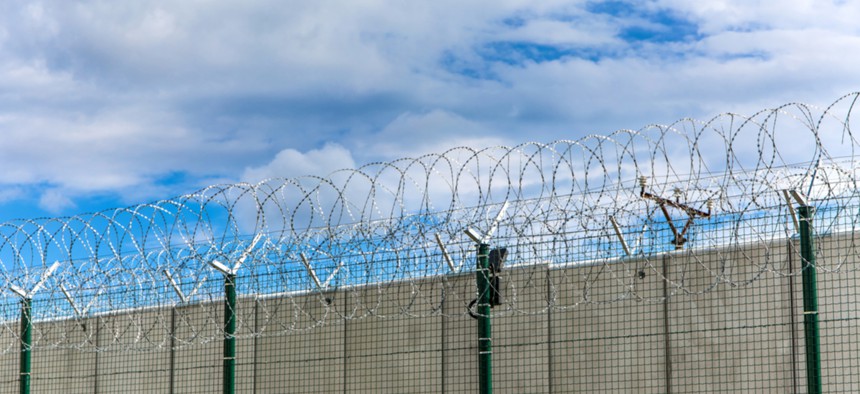Prisons and Jails Remain Outbreak Vectors for Coronavirus

Nine of the 10 largest clusters of coronavirus in America are in prisons and jails. Shutterstock
A new report from the ACLU and Prison Policy Initiative found that state responses to outbreaks in correctional facilities have been largely inadequate.
When the novel coronavirus first made headlines in the U.S., prisons and jails had early warning signs that they might soon face major outbreaks, as the physical constraints of their facilities were going to make it hard for people inside to follow public health guidelines. A new report from the ACLU and Prison Policy Initiative concludes that despite these warnings no states did an even adequate job protecting staff or prisoners from the highly contagious respiratory illness.
“The results are clear: despite all of the information, voices calling for action, and the obvious need, state responses ranged from disorganized or ineffective, at best, to callously nonexistent at worst,” the report reads. “It is clear that no state has done enough and that all states failed to implement a cohesive, system-wide response.”
Since the start of the pandemic, correctional facilities across the country have been hit with major outbreaks of the virus among staff and incarcerated people. Today, nine of the 10 largest identified clusters of coronavirus in America occurred in prisons and jails, according to the New York Times.
Being in jail has become a “death sentence,” according to some incarcerated people and their family members. Correctional staff members and their unions have similarly called the situation “terrifying,” and said that the lack of preparations have made them feel “disposable.”
The ACLU and the Prison Policy Initiative report released on Thursday graded state responses to Covid-19 outbreaks in prisons and jails on a number of factors. Points were awarded to states based on testing efforts for staff and incarcerated people, the amount of PPE provided in the prisons and jails, and whether or not executive orders addressed the release of medically vulnerable people and those with short amounts of time left on their sentences, as well as executive orders that reduced or halted jail admissions for certain crimes. One point was subtracted from states’ scores for every five deaths per 10,000 people in prison.
The highest grades in the report were nine states that received a D-, while most scored somewhere in the mid-teens on a scale of 100.
Many states scored well in certain areas but failed in others. For example, the report found that states with proactive governors who issued executive orders to release medically vulnerable people and those nearing the end of their sentences, like Colorado and Pennsylvania, are still not universally testing staff and are only testing incarcerated people if they become symptomatic.
A representative of the Colorado Department of Corrections said that they are “working very closely with medical professionals, epidemiologists and the Colorado Department of Public Health and Environment to create and implement an effective strategic testing program inside our facilities and offices.” A representative of the Pennsylvania Department of Corrections said that they are performing “CDC recommended testing and contact tracing” and working closely with the state health department “to make sure we react swiftly when the virus is detected.”
The highest scoring state was Tennessee, one of only five states, along with Michigan, Massachusetts, West Virginia, and Vermont, that implemented universal testing of incarcerated people and staff.
In announcing the state’s mass testing efforts on May 1, Tennessee Gov. Bill Lee said that “knowing the extent of the virus’s spread within our correctional facilities is critical, as incarcerated individuals remain one of the most vulnerable populations during this pandemic.” The testing program followed reports that coronavirus was spreading rapidly through some city jails in the state— and one correctional facility reported more than 1,200 positive cases.
The lowest scoring state was Wyoming, which has kept many of its plans for Covid outbreaks in prisons and jails out of public view. Despite that, Wyoming is one of only three states, along with Idaho and Hawaii, that has reported no positive cases among incarcerated people. The Wyoming Department of Corrections said that their “staff remain diligent in their effort to ensure proper sanitization, social distancing and personal protective equipment recommendations are being adhered to in all WDOC facilities.”
More than 70,000 people in prisons across the country have tested positive for the virus. Cases in prisons and jails have risen sharply in the past few weeks—something potentially linked to mass arrests of protesters in some cities. The increase in all correctional facilities has officials worried; experts warned, for example, that the rise in cases at San Quentin State Prison in California could have “dire implications” for the San Francisco Bay Area.
Of those who have been infected across the country, 570 incarcerated people and more than 50 correctional officers have died. The report acknowledges that, as of right now, there is no reliable way to track deaths that occur in the communities surrounding prisons and jails from the spread of the virus outside facility walls by staff and visitors.
Udi Ofer, director of the ACLU’s Justice Division, laid the blame for the situation at the feet of governors who have “failed to take adequate steps” to address the outbreak of Covid-19 in prisons. States’ responses to coronavirus in prison show a “callous disregard…[for] the lives of people in jails and prisons,” she said.
“From the outset of the pandemic, public health experts sounded the alarm that without swift and drastic actions, prisons and jails across the country would see severe outbreaks of Covid-19,” Ofer said in a statement. “Today, prisons and jails are ground zero for the Covid-19 pandemic, inflicting particular devastation on Black and Brown people, yet prisons and jails continue to be largely ignored in the government’s response to the pandemic.”
Emma Coleman is the assistant editor for Route Fifty.
NEXT STORY: Texas and Florida Restricting Bars Amid Coronavirus Surge






